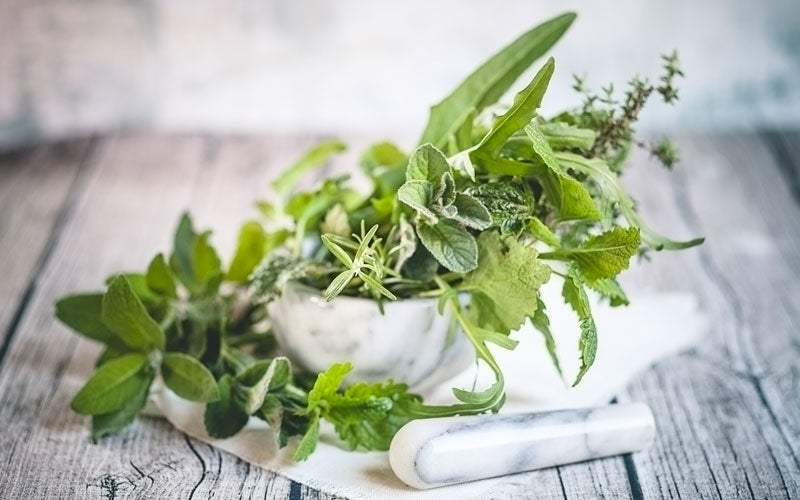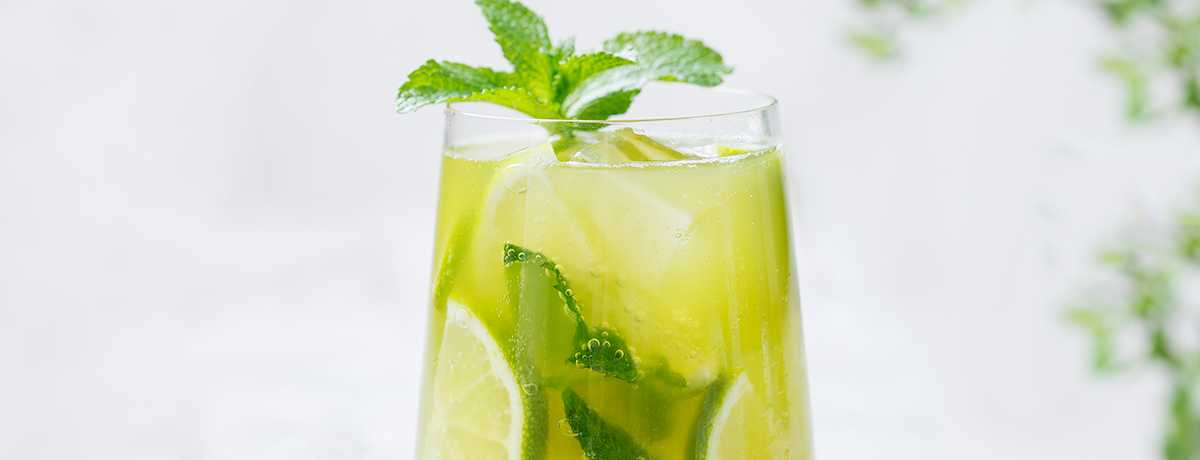Herbs: From kitchen flavors to natural remedies
 ©Westend61
©Westend61
The wide range of herbs available to us today add a variety of tastes and textures to our diets. In addition to their crucial role in many cuisines, these plants are also still used as remedies for various ailments. Keep reading to find out more!
What Are Herbs?
Professional chefs and passionate home cooks know that herbs are an integral part of the cooking process. After all, their variety provides unique, fresh, aromatic components to dishes. So we can tell you a thing or two about their flavors in home cooking, but first let’s go back to the beginning: What plants are considered herbs?
Herb is a collective term that includes edible annual, biennial, and perennial plants. All of them are classified as either herbaceous – i.e. without woody stems, like basil – or half-shrubs like rosemary.
Another distinction is often made between culinary and medicinal herbs, although many herbs, such as sage, serve as both. A culinary herb is any herb used to season dishes by adding or enhancing flavor, like basil. Some are also used to make certain dishes easier to digest. For medicinal herbs, it’s not about the culinary properties of the herb, but its properties for curing or alleviating ailments instead.
Browse through our recipes here
And then, of course, there are also herbs that grow in the wild, whether in your own garden, along the road, or in the forest. Even though they aren’t deliberately cultivated, these plants are nevertheless popular with many aficionados. If you’d like to get the most out of your garden, you can also deliberately grow a garden herb like mint or basil.
Important: if you aren’t really familiar with herbs and plants growing in the wild, or accidentally in your garden, you shouldn’t just harvest them without some guidance. Some plants may grow to look similar to an edible herb like sage, but still be dangerous for humans.
What’s the Difference Between Herbs and Spices?
Herbs are used for seasoning, among other things, so they’re also a kind of spice, right? Not quite. It’s the different parts of the plants that are put into these two categories for cooking – leaves, stems, and flowers are usually considered herbs, while seeds, bark, roots, and dried fruit are spices.
But there’s another thing that can distinguish herbs and spices, if you want to be more precise, and that is the strength of the flavor. Spices are usually more potent and therefore used more sparingly.
What Different Herbs Are There?
Anyone who is already a fan of herbs anyway knows that there is quite a large selection of popular ones growing today. Listing each herb would go far beyond the scope of this article. But we still don’t want to miss the opportunity to list a few of our favorites, such as basil, which is more than just an indispensable part of Italian cuisine. Other herb classics include thyme, cilantro, rosemary, sage, oregano, marjoram, parsley, and mint. But chives, wild garlic, dill, fennel, cress, lavender, laurel, lemon balm, starflower, savory, wormwood, arugula and pimpernel are also often used dried or fresh in various cuisines.
Tips: Buying and Storing Culinary Herbs
The easiest herbs to find are usually the dried ones in the supermarket, but fresh herbs are also common now. If you’re looking for the whole plant or to grow some fresh herbs for the garden from seeds, check out a nursery or hardware store since they’ll usually have a larger selection, especially of seeds. When you buy, look for organic products, so you know no synthetic pesticides were used.
After you’ve taken your favorite fresh herbs home, what’s the next step? They need a thorough cleaning! Wash the herb under running water to remove whatever’s left of the soil it was growing in and dry it off with a paper towel or a clean kitchen towel. Then, depending on the herb, strip the leaves or flowers from the stem and break them down into smaller pieces with a knife, scissors, or mortar before using it in your recipe.
If you want to store a fresh herb for a bit before cooking, it is best to keep it whole. After washing the herb, put it in a freezer bag or a plastic container together with a piece of paper towel. Then it’s off to your fridge’s vegetable compartment – and don’t forget to use it within the next three days so it’s still fresh. By the way: some fresh herbs, like dill and basil, are sensitive to the cold and should not be stored in your fridge’s veggie drawer. Make sure you check what’s best.
Our tip: Like to throw an herb or two in a pan and try out delicious new recipes? Take a look at our simple shakshuka with a fresh herb like parsley or basil as a garnish. Equally delicious: our iced green tea with plenty of mint!

Active Ingredients in Herbs and their Medicinal Effects
It’s impossible to draw up a universal list of active ingredients applicable to any herb, but suffice to say they’re generally thought to have beneficial effects on your well-being and health – whether as culinary or medicinal herbs. But it’s still important to note: the health effects of herbs haven’t been well researched yet, so it’s difficult to come to any clear conclusions on their uses.
Independent of any other benefits, most herbs also pack a boost of nutrients with a solid dose of vitamins and minerals. Secondary substances like flavonoids may also protect your cells, while bitter components stimulate your gastrointestinal tract. And don’t forget the essential oils derived from many herbs, which are even said to have some effects against bacteria and viruses. At least that’s the theory.
All these qualities contribute to the history of medicinal uses for herbs. Herbs and other plants have been used since time immemorial as home remedies to treat diseases and various ailments or as a preventive measure. Dill, fennel, mint, and savory, for example, are said to calm the stomach, while parsley, cress, and basil are said to ease water retention while stimulating the kidneys and the urinary tract. Coriander is also often used as a remedy for digestive problems or feelings of fullness. Others swear by lemon balm for its calming effect, which is said to remedy restlessness, nervousness, and sleep disorders.
The processes for turning fresh herbs into remedies vary greatly. They can be used both externally and internally and can be made into teas or used as oil, ointment, or tincture. Aromatherapy is another popular use.
Herbs: Conclusion
- Herbs can be used for both their culinary and medicinal properties.
- Culinary herbs are added to various dishes to improve their taste, and can even grow in your garden.
- They have active ingredients said to have beneficial effects on your health.
- Their health benefits are why they’ve been used as home remedies for a long time.
Sources for this article
We at foodspring use only high-quality sources, including peer-reviewed studies, to support the facts within our articles. Read our editorial policy to learn more about how we fact-check and keep our content accurate, reliable, and trustworthy.
- DGE (2012): DGE-BW-Forum Kräuter und Gewürze https://www.dge-bw.de/files/dge-bw/uploads-files/PDFs-DGE/dokumentationsband_kruter__gewrze_2012_30.08.2012.pdf
- Bundeszentrum für Ernährung (2020): Kräuter: Gesund essen https://www.bzfe.de/inhalt/kraeuter-gesund-essen-443.html
- Bundeszentrum für Ernährung (2020): Kräuter: Erzeugung https://www.bzfe.de/inhalt/kraeuter-erzeugung-439.html
- Öffentliches Gesundheitsprotal Österreichs (2016): Kräuter und Gewürze in der Ernährung https://www.gesundheit.gv.at/leben/ernaehrung/kraeuter-gewuerze/infos/gesundheit

































